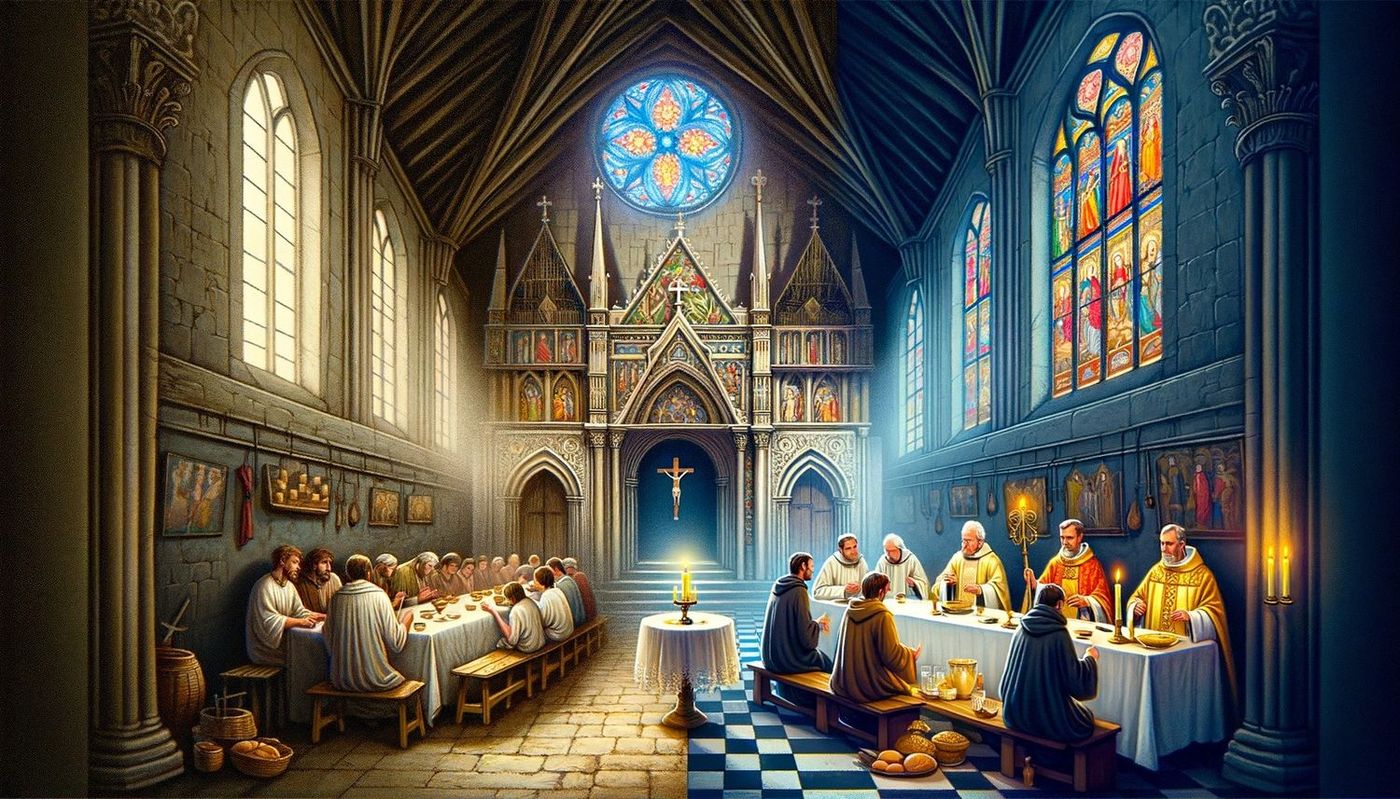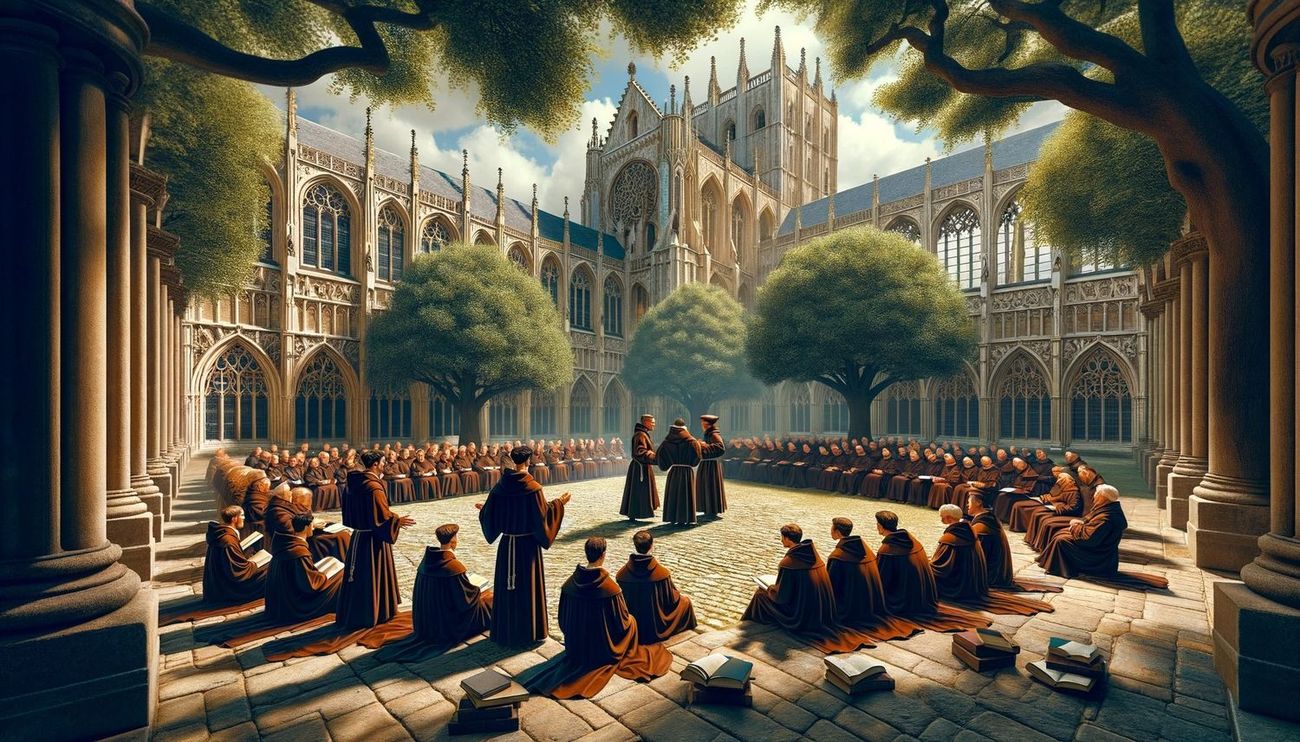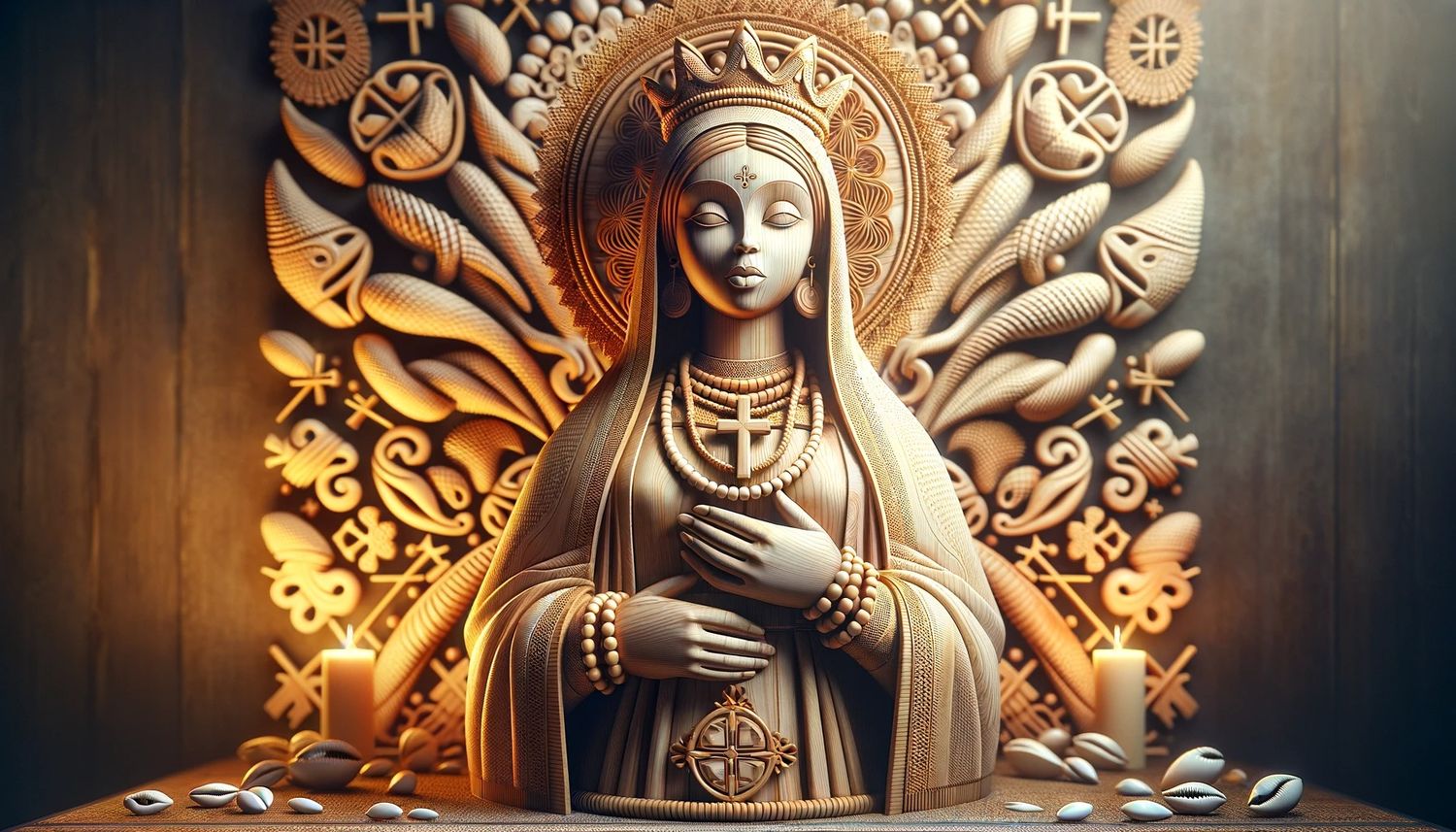Home>Theology and Spirituality>Which Tribe Was Most Successful At Resisting Conversion To Catholicism


Theology and Spirituality
Which Tribe Was Most Successful At Resisting Conversion To Catholicism
Published: February 17, 2024
Ericka Andersen, an editor at Christian.net, expertly merges digital strategy with content creation, focusing on faith and societal issues. Her communication skills enhance the platform's engaging narratives, fostering meaningful dialogue on belief's impact on society.
Discover which tribe successfully resisted conversion to Catholicism and explore the impact on theology and spirituality. Uncover the historical and cultural factors that shaped their resistance.
(Many of the links in this article redirect to a specific reviewed product. Your purchase of these products through affiliate links helps to generate commission for Christian.net, at no extra cost. Learn more)
Table of Contents
Introduction
The history of the interaction between indigenous tribes and European colonizers in North America is a complex tapestry of cultural exchange, conflict, and religious transformation. One significant aspect of this historical narrative is the efforts of Catholic missionaries to convert Native American tribes to Christianity. The process of conversion was often fraught with challenges, as it required the assimilation of new religious beliefs and practices into existing tribal traditions and spiritual systems.
In this article, we will explore the resistance of several Native American tribes to the conversion efforts of Catholic missionaries. By examining the experiences of the Apache, Comanche, Navajo, Sioux, and Iroquois tribes, we will gain insight into the diverse strategies employed by indigenous communities to maintain their traditional spiritual beliefs and practices in the face of external religious pressure.
The stories of these tribes offer a window into the complexities of cultural and religious encounters, shedding light on the resilience and determination of indigenous peoples to preserve their unique spiritual heritage amidst significant external influences. Through this exploration, we can appreciate the rich tapestry of indigenous spirituality and the enduring legacy of Native American traditions in the face of historical challenges.
Overview of Catholic Conversion Efforts
The arrival of European explorers and colonizers in the Americas brought with it the spread of Christianity, particularly Catholicism, as a central component of the colonial enterprise. Catholic missionaries, representing various religious orders such as the Franciscans, Jesuits, and Dominicans, embarked on ambitious missions to convert the indigenous peoples of North America to Christianity. The primary aim of these conversion efforts was to bring the "light of the Gospel" to the native populations and integrate them into the religious and cultural framework of European civilization.
Catholic conversion efforts were multifaceted, encompassing a range of strategies to disseminate Christian teachings and rituals among indigenous communities. Missionaries established missions and churches in native territories, seeking to create centers for religious instruction and worship. They endeavored to translate Christian scriptures and religious texts into indigenous languages, recognizing the importance of linguistic accessibility in conveying the message of Christianity to native populations. Additionally, missionaries often incorporated elements of indigenous customs and traditions into Christian practices, aiming to facilitate the integration of Christianity into the existing cultural fabric of indigenous societies.
The process of conversion was not merely confined to the spiritual realm; it also intersected with broader socio-political dynamics. Missionaries worked in tandem with colonial authorities to exert influence over indigenous communities, utilizing the conversion process as a means of exerting control and fostering allegiance to the colonial powers. This intertwining of religious and political agendas underscored the complex nature of Catholic conversion efforts and their implications for the indigenous peoples of North America.
Despite the fervent zeal of the missionaries and the institutional support of colonial powers, the reception of Catholicism varied widely among different Native American tribes. While some communities embraced elements of Christianity and underwent varying degrees of religious syncretism, others steadfastly resisted the pressures to abandon their traditional spiritual beliefs and practices. The diverse responses of indigenous tribes to Catholic conversion efforts reflect the intricate interplay of cultural, religious, and historical factors that shaped the dynamics of colonial encounters in North America.
The overview of Catholic conversion efforts provides a foundational understanding of the historical context within which indigenous resistance to religious assimilation unfolded. This historical backdrop sets the stage for a deeper exploration of the specific experiences of Native American tribes in their efforts to maintain their spiritual autonomy and cultural identity in the face of external religious influences.
The Apache Tribe
The Apache Tribe, renowned for their fierce independence and formidable warrior culture, demonstrated remarkable resilience in resisting the conversion efforts of Catholic missionaries. Situated in the southwestern region of North America, the Apache people inhabited vast territories characterized by rugged landscapes and a nomadic way of life. This geographical and cultural context profoundly influenced their response to external religious influences, shaping their strategies for preserving their traditional spiritual beliefs and practices.
The Apache Tribe's resistance to Catholic conversion was rooted in their deep spiritual connection to the natural world and their ancestral traditions. Central to Apache spirituality was a profound reverence for the land, embodied in their spiritual practices and ceremonial rituals. This spiritual ethos fostered a profound sense of cultural identity and solidarity within the Apache community, serving as a powerful bulwark against the incursions of external religious doctrines.
The nomadic lifestyle of the Apache people further contributed to their ability to resist religious assimilation. Their mobility across vast territories enabled them to evade sustained contact with Catholic missionaries, limiting the opportunities for prolonged religious indoctrination. This geographical mobility, coupled with a strong sense of tribal autonomy, provided the Apache with a strategic advantage in safeguarding their spiritual sovereignty.
Moreover, the Apache Tribe's formidable reputation as skilled warriors and defenders of their ancestral lands played a pivotal role in their resistance to Catholic conversion. The Apache's steadfast commitment to preserving their cultural heritage and spiritual traditions was intertwined with their enduring struggle to maintain sovereignty over their territories in the face of external encroachments.
The Apache Tribe's resistance to Catholic conversion stands as a testament to their unwavering dedication to preserving their unique spiritual heritage and cultural identity. Their ability to navigate the complex dynamics of colonial encounters while maintaining the integrity of their traditional beliefs exemplifies the resilience and determination of indigenous communities in the face of historical challenges.
The experiences of the Apache Tribe offer valuable insights into the diverse strategies employed by indigenous peoples to uphold their spiritual autonomy amidst external religious pressures. By delving into the nuanced dynamics of the Apache Tribe's resistance to Catholic conversion, we gain a deeper appreciation for the rich tapestry of indigenous spirituality and the enduring legacy of Native American traditions in the midst of historical transformations.
The Comanche Tribe
The Comanche Tribe, renowned for their mastery of horsemanship and their nomadic lifestyle across the southern plains of North America, exhibited remarkable tenacity in resisting the conversion efforts of Catholic missionaries. Situated in the expansive grasslands and prairies, the Comanche people forged a deep spiritual connection to the natural world, which profoundly influenced their steadfast resistance to external religious influences.
Central to the Comanche spiritual worldview was a profound reverence for the land and the sacredness of nature. Their spiritual practices and ceremonial rituals were intricately woven into the fabric of their daily lives, reflecting a holistic understanding of their relationship with the natural environment. This deep-rooted spiritual ethos served as a powerful foundation for their resistance to the incursion of Catholic doctrines, as it fortified their cultural identity and unity as a tribal community.
The nomadic lifestyle of the Comanche, characterized by their mastery of horsemanship and their seasonal migrations across vast territories, played a pivotal role in their ability to resist religious assimilation. Their mobility enabled them to evade sustained contact with Catholic missionaries, limiting the opportunities for extensive religious indoctrination. This geographical mobility, coupled with a strong sense of tribal autonomy, empowered the Comanche to safeguard their spiritual sovereignty amidst external pressures.
Furthermore, the Comanche Tribe's formidable reputation as skilled equestrians and fierce defenders of their ancestral lands was integral to their resistance to Catholic conversion. Their unwavering commitment to preserving their cultural heritage and spiritual traditions was intricately intertwined with their enduring struggle to maintain sovereignty over their territories in the face of external encroachments.
The experiences of the Comanche Tribe offer profound insights into the diverse strategies employed by indigenous communities to uphold their spiritual autonomy amidst external religious pressures. By delving into the nuanced dynamics of the Comanche Tribe's resistance to Catholic conversion, we gain a deeper appreciation for the rich tapestry of indigenous spirituality and the enduring legacy of Native American traditions in the midst of historical transformations.
The Comanche Tribe's resilience in preserving their traditional spiritual beliefs and practices serves as a testament to the enduring strength and determination of indigenous peoples in the face of historical challenges. Their story illuminates the complexities of cultural and religious encounters, highlighting the profound significance of spiritual autonomy and cultural preservation within indigenous communities.
The Navajo Tribe
The Navajo Tribe, also known as the Diné, occupies a significant place in the tapestry of Native American history and spirituality. Situated in the expansive and rugged terrain of the southwestern United States, the Navajo people developed a rich and intricate spiritual tradition deeply rooted in their profound reverence for the natural world and the enduring legacy of their ancestral customs.
Central to the spiritual ethos of the Navajo Tribe is the concept of Hózhǫ́, which encompasses harmony, balance, and beauty in all aspects of life. This fundamental principle permeates Navajo spirituality, guiding their ceremonial practices, healing rituals, and daily interactions with the natural environment. The spiritual landscape of the Navajo people is adorned with sacred mountains, rivers, and landscapes, each imbued with profound significance in their cosmology.
The Navajo Tribe's resistance to the conversion efforts of Catholic missionaries was anchored in their steadfast commitment to preserving their spiritual autonomy and cultural heritage. The enduring legacy of their spiritual traditions, including the practice of ceremonial chants, sand paintings, and intricate craftsmanship, served as a resilient bulwark against external religious pressures.
Moreover, the Navajo people's deep connection to the land and their pastoral lifestyle played a pivotal role in their ability to resist religious assimilation. Their profound reverence for the natural environment, coupled with their nomadic pastoralism, enabled them to maintain a degree of geographical and cultural autonomy, limiting sustained contact with Catholic missionaries.
The Navajo Tribe's enduring resilience in safeguarding their traditional spiritual beliefs and practices stands as a testament to their unwavering dedication to preserving their cultural identity amidst historical transformations. Their ability to navigate the complexities of colonial encounters while upholding the integrity of their spiritual heritage exemplifies the enduring strength and determination of indigenous communities in the face of external pressures.
The experiences of the Navajo Tribe offer profound insights into the diverse strategies employed by indigenous peoples to uphold their spiritual autonomy amidst external religious pressures. By delving into the nuanced dynamics of the Navajo Tribe's resistance to Catholic conversion, we gain a deeper appreciation for the rich tapestry of indigenous spirituality and the enduring legacy of Native American traditions in the midst of historical challenges.
The Sioux Tribe
The Sioux Tribe, comprising the Lakota, Dakota, and Nakota nations, holds a storied legacy deeply intertwined with the spiritual fabric of the Great Plains. Situated in the expansive grasslands and rolling prairies of North America, the Sioux people cultivated a profound spiritual connection to the natural world, which profoundly influenced their steadfast resistance to external religious influences.
Central to the spiritual ethos of the Sioux Tribe was the concept of Wakan Tanka, the Great Spirit, which permeated every facet of their existence. Their spiritual practices, including sacred ceremonies such as the Sun Dance and vision quests, were integral to their cultural identity and communal solidarity. The Sioux people's spiritual worldview was intricately woven into their daily lives, reflecting a holistic understanding of their relationship with the natural environment and the spiritual forces that governed their existence.
The Sioux Tribe's resistance to the conversion efforts of Catholic missionaries was rooted in their unwavering commitment to preserving their traditional spiritual beliefs and practices. The enduring legacy of their spiritual traditions, including the reverence for the buffalo as a sacred symbol and the significance of the Black Hills as a spiritual center, served as a resilient bulwark against external religious pressures.
Furthermore, the Sioux people's deep connection to the land and their nomadic lifestyle played a pivotal role in their ability to resist religious assimilation. Their mobility across the vast expanses of the Great Plains enabled them to maintain a degree of geographical and cultural autonomy, limiting sustained contact with Catholic missionaries and preserving their spiritual sovereignty.
The Sioux Tribe's resilience in safeguarding their traditional spiritual beliefs and practices stands as a testament to their unwavering dedication to preserving their cultural identity amidst historical transformations. Their ability to navigate the complexities of colonial encounters while upholding the integrity of their spiritual heritage exemplifies the enduring strength and determination of indigenous communities in the face of external pressures.
The experiences of the Sioux Tribe offer profound insights into the diverse strategies employed by indigenous peoples to uphold their spiritual autonomy amidst external religious pressures. By delving into the nuanced dynamics of the Sioux Tribe's resistance to Catholic conversion, we gain a deeper appreciation for the rich tapestry of indigenous spirituality and the enduring legacy of Native American traditions in the midst of historical challenges.
The Iroquois Confederacy
The Iroquois Confederacy, also known as the Haudenosaunee, holds a significant place in the annals of Native American history and spirituality. Situated in the northeastern woodlands of North America, the Iroquois people forged a complex and sophisticated confederacy that profoundly influenced their resistance to external religious influences.
Central to the spiritual ethos of the Iroquois Confederacy was the Great Law of Peace, a foundational principle that governed their social, political, and spiritual life. This visionary constitution, established centuries before the arrival of European colonizers, emphasized principles of equity, consensus-based decision-making, and the interconnectedness of all living beings. The spiritual underpinnings of the Great Law of Peace permeated the fabric of Iroquois society, fostering a profound sense of communal harmony and reverence for the natural world.
The Iroquois Confederacy's resistance to the conversion efforts of Catholic missionaries was deeply rooted in their steadfast commitment to preserving their traditional spiritual beliefs and practices. The enduring legacy of their spiritual traditions, including the ceremonies of the Longhouse and the seasonal rituals honoring the cycles of nature, served as a resilient bulwark against external religious pressures.
Furthermore, the Iroquois people's intricate system of governance, characterized by a complex network of clans and councils, played a pivotal role in their ability to resist religious assimilation. The confederacy's political structure, which upheld principles of autonomy and collective decision-making, provided a framework for preserving their spiritual sovereignty amidst external pressures.
The Iroquois Confederacy's resilience in safeguarding their traditional spiritual beliefs and practices stands as a testament to their unwavering dedication to preserving their cultural identity amidst historical transformations. Their ability to navigate the complexities of colonial encounters while upholding the integrity of their spiritual heritage exemplifies the enduring strength and determination of indigenous communities in the face of external pressures.
The experiences of the Iroquois Confederacy offer profound insights into the diverse strategies employed by indigenous peoples to uphold their spiritual autonomy amidst external religious pressures. By delving into the nuanced dynamics of the Iroquois Confederacy's resistance to Catholic conversion, we gain a deeper appreciation for the rich tapestry of indigenous spirituality and the enduring legacy of Native American traditions in the midst of historical challenges.
Conclusion
The resistance of Native American tribes to the conversion efforts of Catholic missionaries stands as a testament to the enduring strength and resilience of indigenous communities in the face of historical challenges. The experiences of the Apache, Comanche, Navajo, Sioux, and Iroquois tribes offer profound insights into the diverse strategies employed by indigenous peoples to uphold their spiritual autonomy amidst external religious pressures.
Across the varied landscapes and cultural tapestries of North America, indigenous tribes demonstrated remarkable tenacity in preserving their traditional spiritual beliefs and practices. The Apache Tribe, renowned for their fierce independence and nomadic lifestyle, upheld their spiritual sovereignty through a deep reverence for the land and a formidable reputation as skilled warriors. Similarly, the Comanche Tribe's mastery of horsemanship and profound connection to the natural world fortified their resistance to external religious influences, while the Navajo Tribe's spiritual ethos of Hózhǫ́ and reverence for the land served as a resilient bulwark against religious assimilation. The Sioux Tribe's profound spiritual connection to the Great Spirit and the natural world, coupled with their nomadic lifestyle, enabled them to safeguard their spiritual sovereignty amidst external pressures. The Iroquois Confederacy's foundational principles of equity, consensus-based decision-making, and reverence for the interconnectedness of all living beings provided a framework for preserving their spiritual autonomy.
The diverse strategies employed by these tribes underscore the intricate interplay of cultural, historical, and geographical factors that shaped their responses to Catholic conversion efforts. The enduring legacy of indigenous spirituality, manifested in ceremonial rituals, communal solidarity, and reverence for the natural world, served as a resilient force in the face of external religious pressures.
As we reflect on the resistance of these tribes, we gain a deeper appreciation for the rich tapestry of indigenous spirituality and the enduring legacy of Native American traditions. Their stories illuminate the complexities of cultural and religious encounters, highlighting the profound significance of spiritual autonomy and cultural preservation within indigenous communities.
Ultimately, the resistance of Native American tribes to Catholic conversion exemplifies the enduring strength and determination of indigenous peoples in preserving their cultural identity and spiritual heritage. Their experiences serve as a poignant reminder of the resilience and vitality of indigenous traditions, which continue to enrich the tapestry of human spirituality and cultural diversity.














